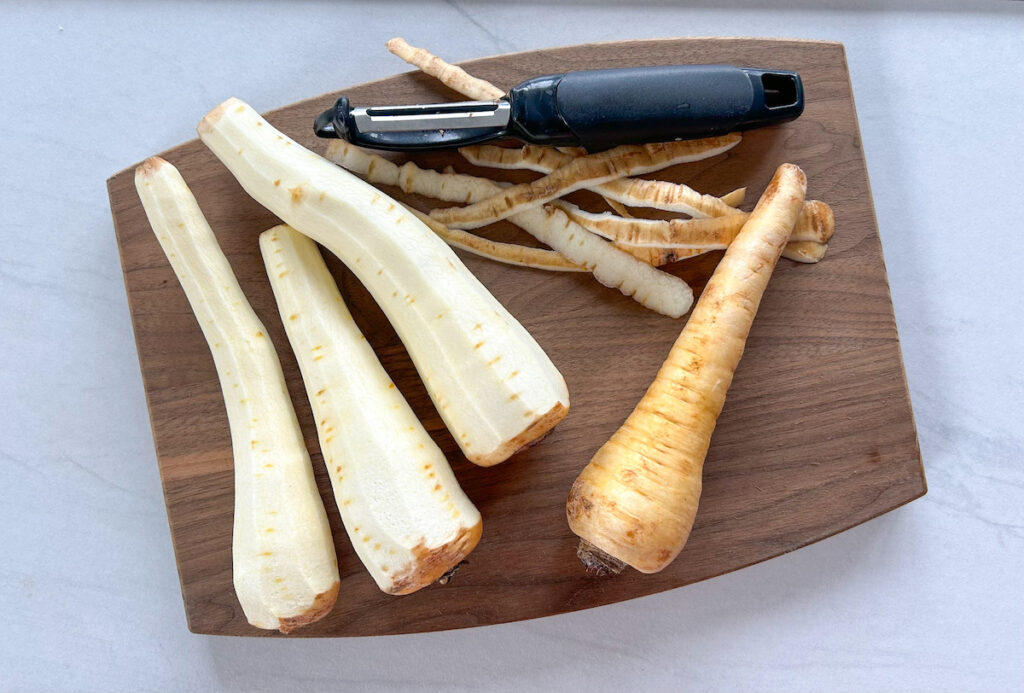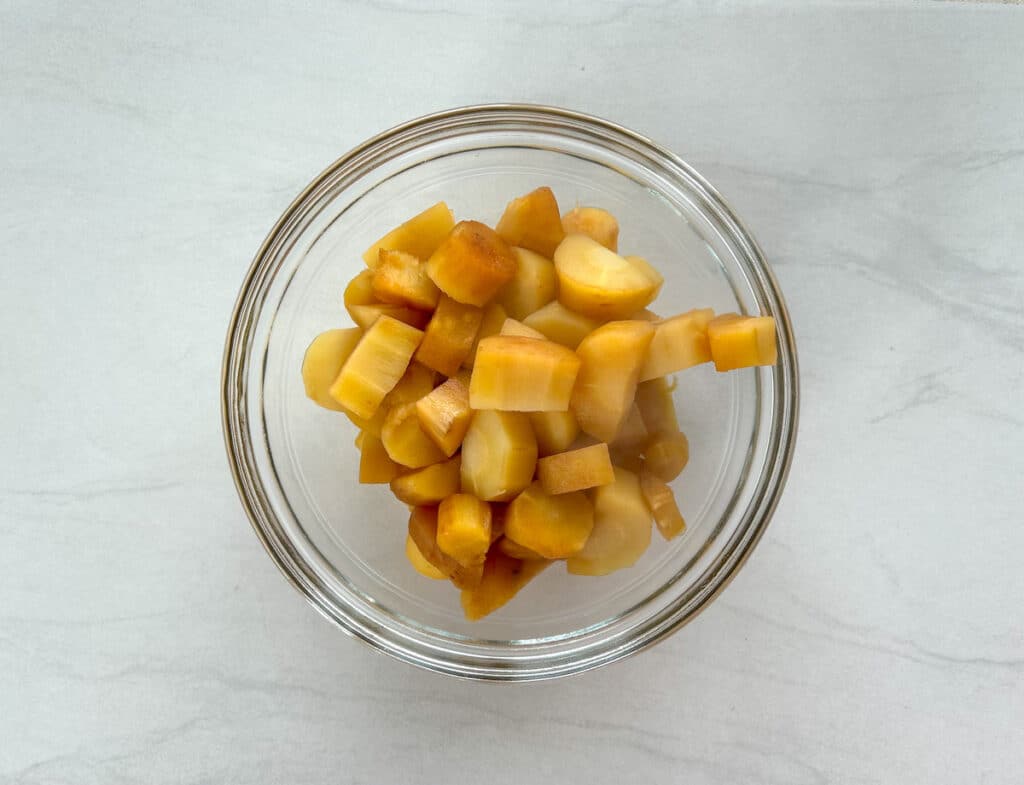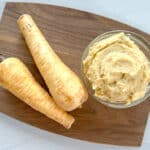Parsnip Puree is a great way to introduce a new food to your baby. This recipe is quick, easy, and full of nutrients. Which makes it a great option for baby-led weaning!
Although the world of starting solids can be daunting, making purees from home doesn’t have to be complicated. Purees are smooth in texture, and usually made from just one or two ingredients.
In this case, parsnip puree is about as simple as it gets – just a couple of ingredients! But although it’s simple, it’s packed with vitamins and minerals for your baby.
Also, its an extremely versatile recipe. Because parsnip has a fairly tame flavor, It can act as a great base puree to introduce new spices or herbs to your baby.
What Does Parsnip Taste Like?
Parsnip is a root vegetable related to carrots and parsley. They taste slightly sweet with a nutty flavor, similar to winter squash.
They have a similar texture to a carrot or potato, so they are often prepared in similar ways! Blended into soups, fried into chips, or roasted with herbs and spices.
Benefits of Parsnip for Baby
Stage 1 Weaning Food
Parsnip puree is considered a Stage 1 Weaning Food. This means that it is a safe option to introduce as your child starts solids. These stage 1 foods are soft in texture or thin purees.
Other Stage 1 foods include:
- Any pureed vegetable or fruit
- Yogurt
- Mashed Avocado
- Apple sauce
- Oatmeal
Rich in Nutrients
Parsnip is packed with essential nutrients such as vitamin C, vitamin K, folate, potassium, and manganese. These nutrients play important roles in immune function and bone health.
For more foods that promote a healthy immune system for kids, read here.
High Fiber
Parsnips are high in insoluble fiber, which promotes digestive health by preventing constipation and supporting a healthy gut microbiome.
For more ways to support your baby’s gut health, add natural sources of probiotics into their diet.
How to Make Parsnip Puree
Peel & Prep
Start by washing and peeling the parsnips thoroughly. Once peeled, chop them into small, uniform pieces. This ensures even cooking and makes the puree easier to blend later on.

Steam the Parsnips
Place the chopped parsnips in a steamer basket over a pot of boiling water. Cover with a lid and steam for about 10-15 minutes, or until the parsnips are tender and easily pierced with a fork. You can also stem the parsnips by placing them in a covered pan with 1” of water.
Fun Fact – Steaming retains more nutrients compared to boiling, making it the preferred method for baby food preparation.

Blend
Once the parsnips are cooked, transfer them to a blender or food processor. Add your olive oil or breast milk to achieve the desired consistency.
Variations
The beauty of this recipe is that it’s extremely versatile. The texture or flavor can be adjusted to fit your baby’s stage of weaning or taste preferences.
Some of my favorite ways to adjust this recipe include:
- Fall Treat: Adding cinnamon, nutmeg, and a touch of maple syrup
- Italian: add basil, thyme, and garlic
- High-Iron: mix in any high-iron food like beans, lentils, or spinach
How to Store Baby Purees
You can store the parsnip puree in an airtight container in the refrigerator for up to 3 days. You can also freeze the puree in ice cube trays for longer storage, then transfer the frozen cubes to a freezer bag once solidified.
To serve from frozen, reheat in the microwave or stovetop. Just make sure to double-check the temperature before serving.
Other Recipes For our Babies and Toddlers
If your child is ready to move on from Stage 1 of baby-led weaning, and onto thicker textures and even solids, check out these other recipes!
Easy Hummus for Babies and Toddlers
Parsnip Puree For Baby
Ingredients
- 4 parsnips, peeled and diced (about 380 grams)
- 1/4 cup olive oil or breast milk
Optional Iron-Boosting Add-Ins
- 1/2 cup chickpeas
- 1/2 cup lentils cooked
- 1/2 cup tofu
- 1 cup spinach cooked or uncooked
- 1/2 cup navy beans cooked
Optional Add-Ins to Introduce New Flavors
- 1 tsp cinnamon, nutmeg, or clove
- 1 tsp herbs – basil, thyme, oregano, etc
- 1 tsp garlic or ginger
Instructions
- Wash and peel the parsnips thoroughly
- Once peeled, chop them into small, 1" pieces. This ensures even cooking and makes the puree easier to blend later on
- Place the chopped parsnips in a steamer basket over a pot of boiling water. Cover with a lid and steam for about 10-15 minutes, or until the parsnips are tender and easily pierced with a fork. If you don't have a steamer basket, you can steam the parsnips in a covered saucepan with 1" water
- Once the parsnips are fork-tender, transfer them to a blender, food processor, or immersion blender. Add the olive oil or breast milk slowly until you've acheived a creamy and smooth consistency
Store for Later
- Any leftover parsnip puree can be stored in an airtight container in the refrigerator for up to three days. For longer storage, consider freezing the puree in ice cube trays. Once frozen, transfer the cubes to a freezer-safe bag or container, and thaw individual portions as needed.
This post may contain affiliate links, meaning I may receive a commission if you decide to purchase through my links, at no cost to you. For more information, please read my Terms of Use and Service.

